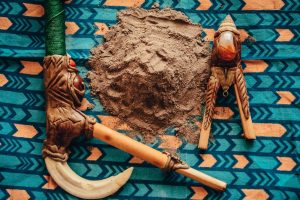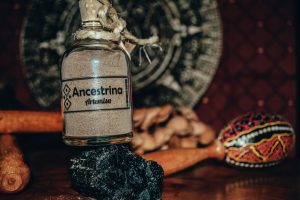How is Rapé made?
The Tobacco that the Amazon tribes use to make Rapé is grown by themselves and it is free of harmful additives, pesticides and fertilizers. During the different phases of its cultivation and preparation tobacco is “prayed” through songs and rituals.
( What is rapé? )
The production of rapé is simple, the most important thing is to accompany it with the appropriate ritual and prayer.
First, the tobacco leaves are harvested and leave to dry. Once they are dry, they are crushed and then sifted until a very fine powder is obtained. The person doing this must concentrate in absolute silence, since it is considered that much of the “force” present in the Rapé comes from the intention of the person who prepares it. This tobacco base is mixed with other plants, and some minerals such as shell lime, and ashes from ceremonial fire (a fundamental part of the sacred alchemy of this medicine).
( History of rapé )
Ashes and Rapé
One of the two essential ingredients in Rapé is ash, which is probably the most mysterious and unknown. The ash serves as a chemical activator that gives strength to medicine. It is the fire element added to the earth, is what gives strength and elevates you . All the Rapés we know and love use it. The way the bark is burned to obtain a good result is an art, since it requires knowledge and experience. The fire that burns the bark should not burn too much, but it should not be to soft either. When Rapé is produced, the intention and the mood are essential, everything that the person thinks and wants when making the medicine is transferred and stored in that medium. This is why, it is important that the people who produce medicine do it with clean intentions, a positive attitude, that they be kind and have a certain level of spiritual evolution. In general, people think that ash is ash and there is nothing else, but nothing could be further from the truth. Getting a nice white ash is quite tricky. When wood is burned, the cellulose burns into the white ash that we see, but most of the salts, alkaloids and other particles survive the fire and remain present in the ash in different proportions. From an alchemical point of view, the ashes represent the body of the crust in concentrated form. These ashes contain the mineral salts of the bark. On a more subtle and energetic level, the ashes, after their transformation and purification process, bring the fire element to medicine. Tobacco represents the earth element. Smoking tobacco has a grounding effect, much like traditional ashless rapé. Shamanic Rapé is more stimulating and takes us to another level of perception.


Ash types
The texture of the wood gives the consistency to the ash, that is why most types of wood used for Rapé ashes have a tight grain, and they are very hard and dense. Trees with softer types of wood do not produce good ashes, they do not give strength to the medicine and the Rapé spoils easier. There are some exceptions, such as certain types of vines, but it is a general rule of thumb. The most common ash used for Rapé is Tsunu, the classic ash of the Yawanawá. Other ashes commonly used are Murici, Pau Pereira, Parika, Cacao, Cumaru, Mulateiro and Canela de Velho. Some rarer are those of Sapota, Balsamo and Emburana, among others. Traditionally, Pajes who make Rapé burn only the bark of most varieties . Nowadays, with the expansion of the consumption of Rapé, some manufacturers generally burn the bark and the wood to increase the yield. Apparently, the bark contains most of the properties, we can see that many medicinal trea teas and other preparations are made from the bark, almost never from the wood. The same thing happens with ashes. Unfortunately, not everyone burns the right wood, there are always unethical people or people without the proper knowledge, this is why it is always good to know the source of your medicine.
( Know three benefits of rapé as ancestral medicine )
Ashes around the world

Many of the indigenous sacred medicines and stimulants used around the world make use of ash as a chemical activator: The inhabitants of the Andes mountains who chew coca leaves,the Indians (of India) who chew Bread, the betel nut and its leaf, the tribes who use the Yopo; They all use the same technique of using their favorite plants combined with a foundation activator. It can be in the form of lime taken from crushed shells, baking soda, ash, or other sources. The ashes used with coca leaves in Bolivia are made from quinoa, bananas and other plants. In West Africa they make their traditional soap with ashes. Again, they burn a certain mixture of plant materials and mix these ashes with oils to create a reaction that turns the oil into soap. This soap is known to be very good for the skin, but it is also used in religious practices for energy cleansing. In fact, the transformation of materials through fire is the essence of the ancient art of alchemical transformation. Fire transforms and has the power to purify everything it touches. In Ayurvedic medicine there is an extensive science, a form of alchemy related to the manufacture and application of medicinal ashes, the so-called Bhasmas. They produce ashes of a great variety of substances, of plants but also of minerals and even certain metals. Each substance burned and transformed by fire has its own properties and its own use. The Bhasmas have a special place in Rasayana, the science of rejuvenation. Today,this practice, even in Ayurveda, has almost disappeared. Just to mention it, Ayurveda also has the practice of Nasya, which is the use of medicinal tobacco that is gently blown into the nasal passages for a variety of ailments.
